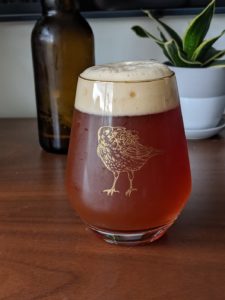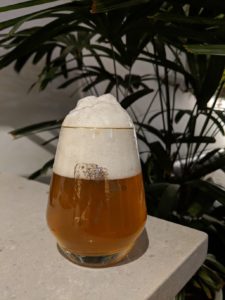It’s been a good while since I brewed a barleywine, and I’d like to make this an annual tradition. To get further mileage out of the brew day, half was fermented clean as a barleywine while the other half received a mixed brett culture as well and aged as an old ale. Depending on how things go, the old ale may become a solera or packaged in full.
Brew Date: Dec 28th 2017
OG: 1.091 (Target 1.100)
FG: 1.021 (Target 1.025)
IBU: 55
ABV: 10.0%
90% Floor-malted Maris Otter (16.20 lbs)
7.5% Mecca Grade Opal 44 (1.35 lbs)
2.5% Crystal 120 (0.45 lbs)
Hop Extract to 50 IBU @ 90 min (9 g)
1 oz Centennial at 15 min
Oxford Ale (2.3 gals): Fermented with WYeast 1728 (~160B cells)
Woodstock (2.0 gals): Fermented with WYeast 1728 (~100B cells) + Imperial ‘Suburban Brett’ (~160B cells)
Above: Woodstock drank July 11, 2019 after approximately 6 months in bottle. Carbonation took a long time, but reached the right level.
Brewday Notes:
Started at 4:00pm, later than I’d like to start on a long-boil brew. Originally I was intended to boil for 2.5 hours, but due to poor efficiency I decided to keep boiling until the gravity got high enough. DME would have been a simpler solution. In the end boiled 4 hours on the nose, got OG up to 1.091, still shy of the 1.100 target. I need to stop expecting near-70% efficiency on big grain bills.
Thanks to a big, 3-stage starter split between the two carboys and a good hit of pure O2 after transfer, activity was underway within 8-10 hours. Fermentors were kept in the beer cellar (air temp 58F).
[Jan 15, 2018] – Gravity check on the Oxford carboy, SG is 1.025 currently for 8.8% ABV. Nose is largely toffee and taste follows (other than the yeast character from being so young). Not a lot of alcohol coming through, seems good so far though a smaller beer than intended.
[Feb 4, 2018] – Bottling day, SG down to 1.021.
[Dec 26, 2018] – Bottled the old ale portion (Woodstock) at an FG of 1.014, with 16g of table sugar. Managed 29 x 375mL bottles.
Tasting Notes (Oxford Ale):
After a few months, Oxford ale was a bit of a fruity malt bomb, which wasn’t really the intent, though it was fine to drink. After around 8 or 10 months though it started to become more caramel-forward and more in line with the desired flavour profile. It’s sneaky for around 9% ABV, and the sweetness and level of carbonation are spot-on for the style.
[March 2019] Oxford Ale received 2nd place at Cowtown Yeast Wrangler’s competition, with scores of 37/50 and 39/50.


